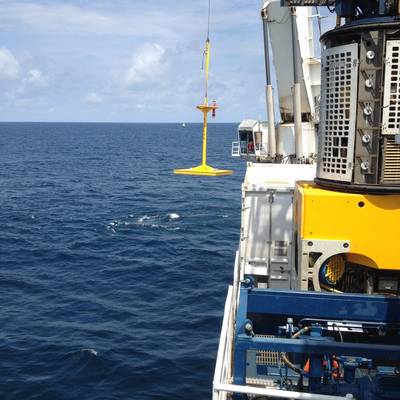Subsea Network Helps Total Save Time at Egina
French oil major Total, operator for the Egina oil field offshore Nigeria, together with its construction and survey partners, has installed a Fusion 6G subsea positioning network to support its development of the $15 billion project.
Supplied by Sonardyne International Ltd, UK, the acoustic technology specified for Egina, which is still ongoing, included a field-wide array of Compatt 6 seabed transponders that were deployed and made ready for work eight days ahead schedule.
Located 150 kilometers off the coast of Nigera, in water depths of up to 1,750 meters, the Egina field covers an area of around 500 square miles. Infrastructure will include an FPSO, an oil offloading terminal and subsea production systems that will included 52 kilometers of oil and water injection flowlines, 12 flexible jumpers, 20 kilometers of gas export pipelines, 80 kilometers of umbilicals, and subsea manifolds. Production at the field is expected to reach 200,000 barrels per day at its peak.
Fusion 6G is Sonardyne’s sixth generation of Long BaseLine (LBL) acoustic positioning system, and is a tool for subsea construction and survey. Using Fusion 6G, major tasks such as structure installation, spoolpiece metrology, ROV tracking and route surveys can be completed quickly, reliably and accurately in any water depth.
Planning for Fusion’s deployment at Egina had begun several months earlier and involved senior project managers and surveyors from Total and its sub-contractors, working with personnel from Sonardyne’s Survey Support Group (SSG), a specialist department staffed by experienced offshore personnel.
The work undertaken by the SGG for Egina included analyzing the proposed location for each of the Compatt transponders in the seabed network, and in doing so, verify that there was clear line of sight between each transponder in order that they can reliably range to each other. In addition, the SSG team mapped out seabed coverage and the expected positioning performance of the Compatts at all points of interest. This essential process involves specialist software and also helps to identify the optimum quantity of transponders that are needed to meet a project’s positioning specification.
At Egina, the investment in time planning acoustic operations onshore, was rewarded with a successful offshore LBL campaign. The wide-area transponder array was deployed, installed and calibrated more than a week ahead of schedule and without any further direct support from Sonardyne and the SSG.
Commenting on the success of the project, Frederic Auger, Chief Surveyor at Total E&P said, “The array installation and subsequent UFR campaign performed at the Egina field, has proven to be an extremely successful demonstration of Fusion’s capabilities. Off the back of it, we will be using it to support ongoing field construction activities throughout the rest of this year and into the 2016 season.” He added, “The system’s quick setup and deployment, meant that the savings in vessel time alone has more than justified our decision to trust in Sonardyne’s low-risk digital technology platform.”











